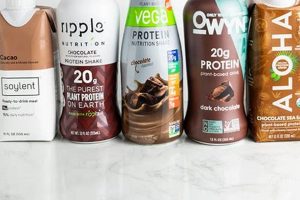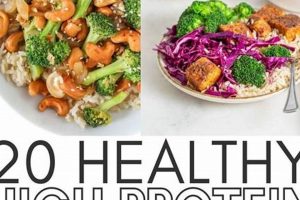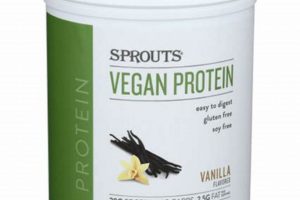A dietary strategy that emphasizes plant-derived foods while ensuring a substantial intake of protein is a growing area of interest for many individuals. This approach necessitates careful food selection to meet daily protein requirements without relying on animal products. Examples include incorporating legumes, tofu, tempeh, nuts, seeds, and certain grains like quinoa into meals.
This method of nutrition can be important for individuals seeking to align their dietary choices with ethical or environmental concerns, or for those with specific health goals. Adequate protein consumption is vital for muscle maintenance, satiety, and overall bodily function. Historically, misconceptions about plant-based protein sources have led to concerns about their completeness and bioavailability; however, a well-planned approach can address these concerns effectively.
Therefore, further exploration of specific plant-based protein sources, strategies for combining foods to ensure complete protein intake, and sample meal plans will provide a more comprehensive understanding of how to successfully implement this dietary strategy. This also includes addressing common concerns and misconceptions, offering practical tips, and considering the role of supplementation.
Tips
Effective implementation requires careful planning and a thorough understanding of plant-based protein sources.
Tip 1: Prioritize Legumes: Incorporate beans, lentils, chickpeas, and peas into daily meals. These are excellent sources of protein and fiber, supporting satiety and digestive health. For example, lentil soup or chickpea curry provide significant protein boosts.
Tip 2: Embrace Tofu and Tempeh: These soy-based products are versatile protein sources. Tofu can be used in stir-fries, scrambles, or grilled, while tempeh offers a firmer texture and nutty flavor. Marinating these items enhances their flavor profile and palatability.
Tip 3: Discover Nutritional Yeast: This deactivated yeast provides a cheesy flavor and is rich in B vitamins, including B12. Sprinkle it on pasta, popcorn, or vegetables to add a nutritional boost.
Tip 4: Combine Grains and Legumes: Consuming grains (like rice, quinoa, or oats) in combination with legumes (like beans or lentils) helps to create complete protein profiles. Consider meals like rice and beans or quinoa salad with chickpeas.
Tip 5: Incorporate Nuts and Seeds: Almonds, chia seeds, flax seeds, hemp seeds, and pumpkin seeds offer protein, healthy fats, and essential nutrients. Add them to smoothies, salads, or use them as toppings.
Tip 6: Read Food Labels Carefully: Pay attention to the protein content per serving and serving size to ensure adequate intake. Compare different products to select those with a higher protein density.
Tip 7: Consider Protein Supplements: If meeting protein goals proves challenging through whole foods alone, consider a plant-based protein powder supplement, such as pea protein, brown rice protein, or soy protein. Ensure the supplement is third-party tested for quality and purity.
These strategies ensure sufficient protein intake and maximize the nutritional benefits of a carefully curated selection of plant-based items.
Following these tips provides a solid framework for navigating the dietary strategy successfully and maximizing its potential benefits.
1. Legumes
Legumes form a cornerstone of a high protein vegan diet plan due to their substantial protein content relative to other plant-based food groups. This dietary strategy relies heavily on legumes because they supply essential amino acids, which are building blocks for proteins necessary for numerous bodily functions. The inclusion of legumes directly influences the success of achieving adequate protein intake within a vegan framework. For example, a serving of cooked lentils contains approximately 18 grams of protein, making it a significant contributor to daily protein needs.
Beyond their protein content, legumes provide dietary fiber, which aids in satiety and digestive health. This is important because high-protein diets often require sustained feelings of fullness to prevent overconsumption of less nutritious foods. Furthermore, legumes such as soybeans can be processed into various products like tofu and tempeh, expanding their versatility in meal preparation. Their environmental impact is also lower compared to animal-based protein sources, aligning with sustainability principles often associated with veganism.
In summary, the connection between legumes and this plan is one of necessity. Without consistent and varied consumption of legumes, meeting protein requirements on a vegan diet becomes significantly more challenging. Understanding this connection is practically significant for individuals seeking to adopt a nutritionally sound and sustainable vegan diet, because a plan without legumes would require significantly more planning and supplementation to be successfully executed.
2. Tofu & Tempeh
Tofu and tempeh occupy a crucial position within a high protein vegan diet plan, serving as readily available and versatile sources of complete protein. Their significance arises from the fact that they are derived from soybeans, a legume known for containing all nine essential amino acids. This characteristic distinguishes them from many other plant-based protein sources, making them invaluable for individuals following a vegan diet who need to ensure a comprehensive amino acid profile. For example, a four-ounce serving of tofu can provide approximately 8 grams of protein, while the same amount of tempeh offers around 19 grams. These quantities substantially contribute to daily protein requirements without relying on animal products.
The cause-and-effect relationship is evident: incorporating tofu and tempeh into the dietary framework directly supports the ability to meet protein goals, thereby facilitating muscle maintenance, repair, and various physiological functions. These soy-based products can be prepared in diverse ways, ranging from stir-fries and scrambles to grilling and baking. Their adaptability enhances dietary adherence by preventing monotony and catering to varied taste preferences. Moreover, the production of tofu and tempeh generally carries a lower environmental footprint compared to animal agriculture, aligning with the ethical considerations often associated with veganism.
In conclusion, the reliance on tofu and tempeh within a high protein vegan diet plan is substantial. Their inclusion mitigates the challenges of obtaining complete proteins solely from plant sources. The availability, nutritional profile, and culinary flexibility of these soy products underscore their importance in fostering successful adoption and sustainability of this dietary strategy. Without consistent access to, and consumption of, tofu and tempeh, this dietary goal becomes significantly more complex, underscoring their practical significance for individuals adopting this approach.
3. Grains Combination
Grains, while not typically considered high in protein individually, play a crucial role in a high protein vegan diet plan when strategically combined. The fundamental connection lies in their complementary amino acid profiles. Many grains are limited in lysine, an essential amino acid, whereas legumes are typically rich in lysine but may be limited in methionine. Combining grains with legumes provides a more complete amino acid profile, effectively addressing the limitations of relying solely on single plant-based protein sources. This combination supports the synthesis of proteins within the body, crucial for muscle repair, growth, and overall physiological function. A practical example includes pairing rice, which is relatively low in lysine, with beans, which are high in lysine, to create a nutritionally complete meal.
The incorporation of grains combination into the plan offers dietary versatility and improved nutrient absorption. Specific pairings like quinoa, a complete protein itself, with lentils, or oats with nuts and seeds, exemplify this approach. This strategy ensures individuals receive a broad spectrum of essential nutrients, including complex carbohydrates for sustained energy, fiber for digestive health, and various vitamins and minerals. The practice of combining grains and legumes addresses concerns about the completeness of plant-based proteins, thereby reinforcing the feasibility of the dietary strategy. Failure to combine different grains and legumes necessitates a more rigorous assessment of dietary intake and potentially, supplementation to ensure adequate amino acid consumption.
In summary, the integration of grains combination is critical for optimizing the nutritional value of a high protein vegan diet plan. By strategically pairing grains with legumes and other complementary plant-based protein sources, individuals can more effectively meet their protein requirements and ensure a well-rounded intake of essential nutrients. This practice is not merely a suggestion but a foundational element for individuals pursuing this diet, minimizing nutritional deficiencies and maximizing overall health benefits. Addressing the limitations of individual plant-based protein sources through strategic combination is essential for the long-term success and sustainability of the diet.
4. Nuts and Seeds
Nuts and seeds are integral components of a high protein vegan diet plan, serving as concentrated sources of protein, healthy fats, and micronutrients. Their inclusion contributes significantly to the nutritional adequacy and palatability of this dietary approach.
- Protein Contribution
Nuts and seeds supplement overall protein intake. While not as protein-dense as legumes or tofu, they provide a consistent source of amino acids. For instance, almonds contain approximately 6 grams of protein per ounce, while chia seeds offer about 5 grams of protein in two tablespoons. Regular consumption of various nuts and seeds ensures a steady supply of protein throughout the day. In a vegan diet, where animal protein is absent, this contribution is particularly relevant.
- Fatty Acid Profile
Nuts and seeds are rich in unsaturated fats, including omega-3 and omega-6 fatty acids, which are essential for cardiovascular health and brain function. Flax seeds and walnuts are notable sources of alpha-linolenic acid (ALA), a precursor to omega-3 fatty acids. These fats contribute to satiety, reducing the likelihood of overeating less nutritious foods. Within the context, these fats complement the lower fat content often found in other plant-based protein sources.
- Micronutrient Density
Nuts and seeds provide a spectrum of vitamins and minerals, including vitamin E, magnesium, zinc, and iron. These micronutrients are vital for various physiological processes, such as immune function and energy metabolism. For example, pumpkin seeds are a good source of zinc, while almonds are rich in vitamin E. This micronutrient profile enhances the overall nutritional value, ensuring that individuals receive a broader range of essential nutrients.
- Dietary Versatility
Nuts and seeds offer culinary flexibility, as they can be incorporated into meals and snacks in numerous ways. They can be added to smoothies, salads, or baked goods. They can also be consumed as standalone snacks. This versatility supports long-term adherence to the diet by preventing monotony. Additionally, nut butters, such as almond or peanut butter (technically a legume), can serve as convenient protein sources. Their role in flavor and texture enhancement further supports their inclusion.
In conclusion, the strategic incorporation of nuts and seeds is essential for optimizing the nutritional profile and sustainability of a high protein vegan diet plan. Their contribution to protein intake, healthy fat content, micronutrient density, and dietary versatility makes them valuable components of a nutritionally complete vegan dietary approach. The integration of nuts and seeds not only addresses protein requirements but also enhances the overall health benefits and adherence to the diet.
5. Supplementation
Within the context of a high protein vegan diet plan, supplementation addresses potential nutritional gaps that may arise due to the exclusion of animal products. It serves as a strategic tool to ensure adequate intake of specific nutrients that are either less bioavailable or less abundant in plant-based diets. Therefore, targeted supplementation becomes a relevant consideration for individuals adhering to this dietary framework to mitigate the risk of deficiencies and support overall health.
- Vitamin B12 Augmentation
Vitamin B12, primarily found in animal-derived foods, is often deficient in vegan diets. Supplementation with cyanocobalamin or methylcobalamin is crucial to prevent neurological and hematological complications. The recommended daily intake varies, but typically ranges from 2.4 mcg to higher doses for individuals with existing deficiencies. Failure to supplement B12 can lead to irreversible nerve damage, making it a critical consideration.
- Vitamin D Optimization
Vitamin D, essential for calcium absorption and bone health, can be challenging to obtain adequately from plant-based sources and sunlight exposure, particularly in certain geographical locations or during winter months. Supplementation with vitamin D2 (ergocalciferol) or D3 (cholecalciferol, preferably from a vegan source such as lichen) can maintain optimal serum levels. Dosage recommendations vary depending on individual needs and sun exposure habits, generally ranging from 600 to 2000 IU daily. Insufficient vitamin D can increase the risk of osteoporosis and immune dysfunction.
- Iron Bioavailability Enhancement
Iron from plant-based sources (non-heme iron) is less readily absorbed compared to heme iron from animal products. Supplementation may be necessary to prevent iron deficiency anemia, especially for women of reproductive age. Ferrous sulfate or ferrous bisglycinate are common forms of iron supplements. Consuming iron-rich foods alongside vitamin C-rich foods can enhance iron absorption. Dosage should be determined by a healthcare professional based on iron status assessments. Iron deficiency can lead to fatigue and impaired cognitive function.
- Omega-3 Fatty Acid Provision
While some plant-based foods, such as flaxseeds and walnuts, contain alpha-linolenic acid (ALA), the conversion to EPA and DHA, the active forms of omega-3 fatty acids, is often limited. Supplementation with algal oil, a vegan source of EPA and DHA, can ensure adequate intake of these essential fatty acids, which are important for cardiovascular health and brain function. Dosages typically range from 250 to 500 mg of combined EPA and DHA daily. Suboptimal omega-3 fatty acid intake may negatively impact cognitive and cardiovascular health.
The strategic utilization of supplementation within a high protein vegan diet plan is not a substitute for a well-planned dietary approach but rather a complementary strategy to address specific nutritional considerations. Careful assessment of individual needs, dietary habits, and consultation with healthcare professionals are essential to ensure safe and effective supplementation practices, thereby mitigating potential risks and optimizing health outcomes.
6. Meal planning
Meal planning is an indispensable component of a successful high protein vegan diet plan. It provides the structured framework necessary to ensure adequate protein intake, nutritional balance, and adherence to dietary guidelines. Without meticulous meal planning, individuals face a heightened risk of nutrient deficiencies, inconsistent protein consumption, and ultimately, failure to achieve the desired health outcomes.
- Protein Source Integration
Meal planning facilitates the strategic incorporation of diverse plant-based protein sources. By mapping out meals in advance, individuals can ensure that legumes, tofu, tempeh, nuts, seeds, and protein-rich grains are consistently included. For example, a typical meal plan might include a lentil soup for lunch, a tofu stir-fry for dinner, and a handful of almonds as a snack. This proactive approach prevents reliance on limited protein sources and ensures a comprehensive amino acid profile.
- Macronutrient Balancing
Effective meal planning ensures an appropriate balance of macronutrientsprotein, carbohydrates, and fatswithin the high protein vegan diet plan. Pre-planning meals allows for controlled portions and mindful combination of food groups. A well-structured plan addresses the need for adequate protein while preventing excessive carbohydrate or fat intake. For example, planning meals that combine protein-rich foods with complex carbohydrates and healthy fats, such as a quinoa salad with black beans, avocado, and vegetables, supports sustained energy levels and satiety.
- Micronutrient Optimization
Meal planning addresses the broader nutritional landscape by ensuring adequate intake of vitamins and minerals. By deliberately including a variety of colorful fruits and vegetables, individuals can safeguard against micronutrient deficiencies. For example, a meal plan might emphasize the inclusion of leafy greens for iron and calcium, fortified plant-based milks for vitamin B12 and vitamin D, and citrus fruits for vitamin C. This holistic approach prevents nutritional gaps often associated with restrictive diets.
- Adherence and Sustainability
Meal planning fosters adherence and promotes the long-term sustainability of a high protein vegan diet plan. By establishing clear meal patterns and preparing food in advance, individuals reduce the likelihood of impulsive food choices and dietary deviations. A structured meal plan reduces decision fatigue, minimizes meal preparation time, and facilitates consistency in dietary habits. For instance, preparing several days’ worth of meals on a weekend promotes adherence throughout the week and simplifies daily routines.
The synergistic relationship underscores the central role of structured meal planning in supporting and optimizing a high protein vegan diet plan. By systematically integrating diverse protein sources, balancing macronutrients, optimizing micronutrient intake, and fostering adherence, meal planning effectively mitigates the challenges associated with this dietary approach and promotes sustainable, healthful outcomes. Consequently, meticulous meal planning emerges not merely as an adjunct but as an essential component for individuals pursuing this dietary strategy.
Frequently Asked Questions
The following questions address common inquiries regarding the implementation and suitability of a high protein vegan diet plan. These responses aim to provide clarity and evidence-based information to support informed decision-making.
Question 1: Is it possible to obtain sufficient protein on a vegan diet without consuming animal products?
Adequate protein intake is achievable through a well-planned vegan diet that incorporates a variety of plant-based protein sources. Legumes, tofu, tempeh, nuts, seeds, and certain grains, such as quinoa, can collectively meet protein requirements when consumed in sufficient quantities and combinations. Strategic meal planning and awareness of protein content in various foods are essential.
Question 2: Are plant-based proteins complete proteins, containing all essential amino acids?
While some plant-based proteins, such as soy and quinoa, are complete proteins, many others are incomplete, lacking one or more essential amino acids. However, consuming a variety of plant-based protein sources throughout the day ensures that all essential amino acids are obtained. Combining complementary proteins, such as grains and legumes, at each meal is not necessary; a balanced intake over the course of the day is sufficient.
Question 3: Does a high protein vegan diet plan support muscle growth and maintenance?
A high protein vegan diet plan can support muscle growth and maintenance, provided that sufficient calories and a variety of plant-based protein sources are consumed. The quantity and quality of protein, alongside resistance training, are primary factors influencing muscle hypertrophy and preservation. Consistent protein intake throughout the day, with particular attention to post-exercise nutrition, is crucial.
Question 4: What are the potential risks associated with a poorly planned high protein vegan diet plan?
A poorly planned high protein vegan diet plan may lead to nutrient deficiencies, particularly vitamin B12, vitamin D, iron, and omega-3 fatty acids. Insufficient intake of these nutrients can result in fatigue, anemia, bone health issues, and neurological problems. Careful meal planning and supplementation, when necessary, are essential to mitigate these risks.
Question 5: Is a high protein vegan diet plan suitable for athletes and individuals with high physical activity levels?
A high protein vegan diet plan can be suitable for athletes and individuals with high physical activity levels, but it requires meticulous planning to meet elevated energy and nutrient demands. Increased protein intake, strategic carbohydrate consumption, and adequate hydration are necessary. Consultation with a registered dietitian or sports nutritionist is recommended to optimize dietary strategies.
Question 6: How can a high protein vegan diet plan be adapted for individuals with specific health conditions, such as diabetes or kidney disease?
Adaptations to a high protein vegan diet plan may be necessary for individuals with specific health conditions. For those with diabetes, careful management of carbohydrate intake and blood glucose levels is essential. Individuals with kidney disease may need to moderate protein intake to avoid exacerbating renal dysfunction. Collaboration with a healthcare professional or registered dietitian is crucial to ensure dietary modifications are appropriate and safe.
In summary, a well-executed high protein vegan diet plan requires careful attention to protein sources, nutrient balance, and individual health needs. Proper planning, supplementation, and professional guidance are essential for maximizing its benefits and minimizing potential risks.
Next, further information on resources, recipes, and guidance will assist with implementing the high-protein vegan diet.
High Protein Vegan Diet Plan
The preceding examination underscores that the high protein vegan diet plan necessitates meticulous attention to detail. Strategic food selection, informed supplementation, and structured meal planning are not merely suggestions, but rather essential components for success. A comprehensive understanding of protein sources, amino acid profiles, and potential nutrient deficiencies is paramount for individuals considering this dietary approach. This requires careful monitoring and appropriate action.
Ultimately, the viability of a high protein vegan diet plan hinges on a commitment to nutritional education and proactive health management. Its successful implementation may require professional guidance to ensure long-term adherence and to optimize both physical and ethical considerations. The significance of this dietary choice extends beyond personal well-being, reflecting a broader movement toward sustainable and compassionate living. The high protein vegan diet plan requires active engagement and understanding.


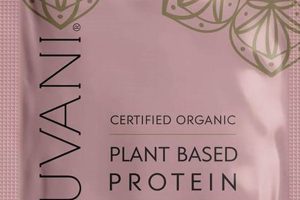
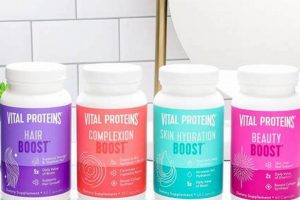
![Boost Protein: Vegan Alfredo Recipe [Healthy & Easy!] Discover Delicious Vegan Food, Beauty Swaps, and Zero-Waste Tips for a Greener Life Boost Protein: Vegan Alfredo Recipe [Healthy & Easy!] | Discover Delicious Vegan Food, Beauty Swaps, and Zero-Waste Tips for a Greener Life](https://thisvegangirl.com/wp-content/uploads/2025/12/th-956-300x200.jpg)
